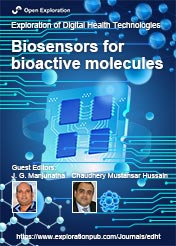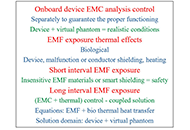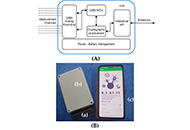
Biosensors for Bioactive Molecules
Guest Editors
J. G. Manjunatha E-Mail
Assistant Professor at Department of Chemistry, Field Marshal KM Cariappa College, A Constituent College of Mangalore University, Kaveri Campus, Madikeri, Karnataka, India
Research Keywords: Biosensor, sensor, electrochemistry, analytical chemistry, neuroscience
Chaudhery Mustansar Hussain E-Mail
Dept. of Chemistry and EVSC at New Jersey Institute of Technology, Newark, US
Research Keywords: Nanotechnology and sensor, advanced materials, environment and sustainability, analytical chemistry, green materials and technology
About the Special lssue
Nowadays, understanding the biological, environmental, and chemical world is increasingly important for numerous research areas. Biosensors are devices comprising a biological and physicochemical segment to detect an analyte by producing a signal that can be measured. Biosensors are integrated receptor–transducer tools that can provide selective quantitative/semiquantitative analytical data through a biological recognition component. A specific biosensor usually includes a biosensing component and a transducer. The sensitive biological element, e.g., tissue, microorganisms, organelles, cell receptors, enzymes, antibodies, nucleic acids, etc., is a biologically derived material or biomimetic component that interacts with or binds to the analyte under study. Biologically sensitive elements can also be engineered by biological engineering. It has various biological applications and is used for the detection of several components such as pollutants, microbial load, metabolites, control parameters, and various other substances. It also has immense applications in the food industry, clinical diagnostics, and various other areas where reliable and precise analyses are required. During the last few decades, numerous biosensing elements and devices have been developed. Biosensors have numerous applications in various fields such as biomonitoring of pollutants, disease diagnostics, the food industry, the medical field, the marine sector, and they provide better stability and sensitivity compared to traditional methods. The most common types of biosensors are electrochemical biosensors, optical biosensors, biological biosensors, electronic nose devices, DNA biosensors, graphene-based biosensors, nanomaterial-based biosensors, enzyme-based, tissue-based, immunosensors, thermal, and piezoelectric biosensors. The goal of this special issue is to provide a platform for research focusing on all aspects of biosensor applications.
Keywords: Biosensors, voltammetry, electrochemical sensors, biologically active molecules, biosensors applications, medicinal applications
Published Articles

